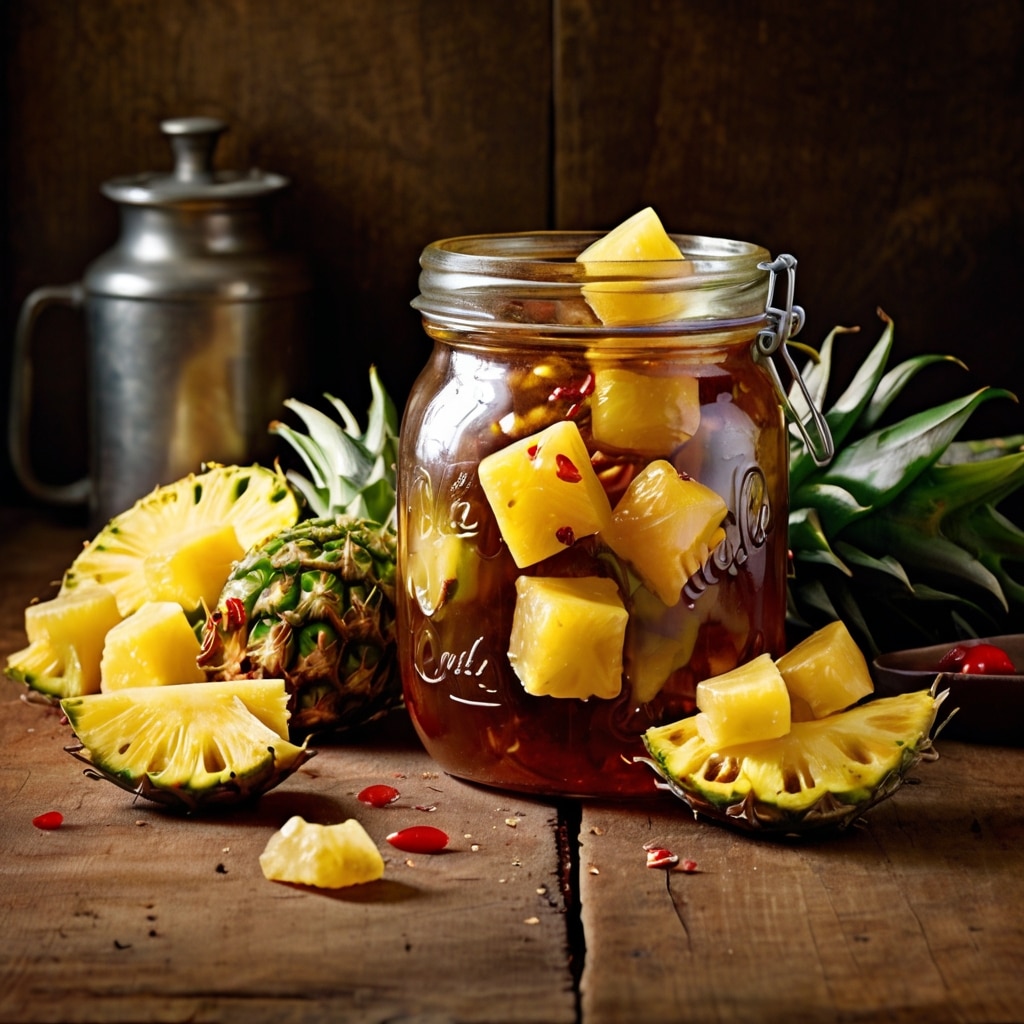Pineapple Cowboy Candy might sound like a dare, the kind of thing you’d expect to find at a roadside fair where everything’s fried or candied. But here’s the twist—it’s not a gimmick. It’s an alchemy of jalapeños, sugar, vinegar, and pineapple that hits sweet, fiery, tangy all at once, like a rodeo on your tongue. The first time I made it, I thought I’d gone too far with the peppers. But then I spooned some over cream cheese with crackers, and the room went quiet. People looked up, nodded, and kept eating. That’s when you know a recipe is magic.
Pineapple Cowboy Candy is basically candied jalapeños with pineapple chunks simmered in a syrupy brine. It’s sticky, shiny, sweet, spicy, and tangy all rolled together. The pineapple doesn’t just sit there—it soaks in the heat and syrup, softening into golden bites that surprise you every time. Unlike plain cowboy candy, the pineapple brings balance, a cooling edge, and a tropical whisper that makes it stand out.
Ingredients & Substitutions
Pineapple Cowboy Candy starts with fresh jalapeños, about 2 pounds, sliced into coins. Use firm, glossy peppers, not wrinkled ones. Freshness keeps the crunch.
Pineapple Cowboy Candy demands real pineapple. Fresh is king here, diced into small chunks, juicy and sweet. Canned works too, but choose chunks in juice, not syrup, unless you want it cloying.
Pineapple Cowboy Candy also needs white sugar—lots of it, around 4 cups. Sugar builds the syrupy glaze, caramelizes the peppers, and locks in flavor. You could swap honey or light brown sugar for deeper notes, but white sugar makes it bright.
Pineapple Cowboy Candy calls for apple cider vinegar. Don’t reach for white distilled; too sharp. The cider vinegar brings mellow tang with a fruity undertone that plays beautifully with pineapple.
Pineapple Cowboy Candy works with spices too: turmeric for warmth, celery seed for earthiness, garlic powder for punch, and a touch of cayenne if you like. Mustard seeds are optional, but they pop and add texture.
Pineapple Cowboy Candy can bend for substitutions. Can’t handle jalapeños? Use banana peppers or poblano for mildness. Want real heat? Mix in serranos or habaneros. Pineapple allergy? Mango chunks are a worthy stand-in, slightly firmer but with equal tropical sweetness.
Step-by-Step Instructions
Pineapple Cowboy Candy begins with slicing jalapeños. Wear gloves—trust me. Capsaicin doesn’t wash off easily, and you don’t want to discover that the hard way hours later. Cut into even slices, about ⅛ to ¼ inch thick.
Pineapple Cowboy Candy next moves to the syrup. In a pot, combine sugar, vinegar, turmeric, celery seed, garlic powder, and a pinch of cayenne. Bring it to a gentle boil, then simmer 5 minutes. The aroma will fill the kitchen—sharp vinegar softened by sweet sugar.
Pineapple Cowboy Candy then welcomes the jalapeños. Toss them in, stir, and simmer about 5 minutes until they soften slightly but stay vibrant. Don’t overcook here or they’ll collapse into mush.
Pineapple Cowboy Candy adds pineapple chunks last. Let them simmer only 2–3 minutes. Pineapple breaks down quickly, and you want tender, syrup-soaked fruit, not jam.
Pineapple Cowboy Candy finishes with canning or cooling. Use sterilized jars if preserving long term. Ladle peppers and pineapple into jars, then cover with hot syrup. Wipe rims, seal, and process in a boiling water bath 10–15 minutes. If you’re just refrigerating, skip the bath and let jars cool before chilling.
Pineapple Cowboy Candy tip: don’t throw away leftover syrup. It’s liquid gold. Brush it over grilled chicken, stir into cocktails, or drizzle on roasted veggies.
Cooking Techniques & Science
Pineapple Cowboy Candy relies on sugar’s preservative power. The high concentration of sugar binds water, making it hostile for bacteria and mold. That’s why this condiment lasts so long when canned properly.
Pineapple Cowboy Candy uses vinegar for acidity, dropping the pH to safe levels. This makes it suitable for water bath canning. It also balances the syrup’s sweetness with sharp tang. Without vinegar, the whole thing would taste flat and cloying.
Pineapple Cowboy Candy benefits from slicing peppers evenly. Uniform thickness means uniform cooking, so no slices end up floppy while others are raw. A mandoline helps if you want perfect rounds, but a sharp knife and steady hand do the trick too.
Pineapple Cowboy Candy science—pineapple contains bromelain, an enzyme that breaks down proteins. That’s why pineapple is often used in marinades. In this recipe, bromelain softens slightly during simmering but still adds that juicy brightness.
Pineapple Cowboy Candy should be canned in glass jars. Metal or plastic leaches flavor, and jars ensure safety and storage longevity. Wide-mouth jars make scooping easier later.
Serving & Pairing Suggestions
Pineapple Cowboy Candy shines as a topping for cream cheese with crackers. Classic, yes, but unbeatable. The creamy fat cools the heat, the sweet syrup drips, and the pineapple bursts through.
Pineapple Cowboy Candy elevates grilled meats. Brush the syrup over pork chops or chicken thighs as they finish cooking. The sugars caramelize, leaving glossy, sticky char.
Pineapple Cowboy Candy can garnish tacos. Try it on pulled pork or brisket tacos, with a crumble of queso fresco. It cuts through richness like a lime wedge, but hotter and sweeter.
Pineapple Cowboy Candy belongs on charcuterie boards. Nestle a small bowl between smoked meats, cheeses, and nuts. It surprises guests, makes them linger.
Pineapple Cowboy Candy even works in cocktails. A spoonful of syrup stirred into a margarita? Dangerous. Sweet heat with tequila is something else. Garnish with a candied jalapeño slice on the rim.
Pineapple Cowboy Candy is also brilliant in sandwiches. Layer it into a turkey club or spread across a Cuban sandwich. The sweet-spicy syrup turns a plain bite into a fireworks show.
Conclusion
Pineapple Cowboy Candy is proof that humble ingredients—jalapeños, sugar, vinegar, pineapple—can be transformed into something unforgettable. Sweet heat is already addictive, but add pineapple and it shifts into tropical territory, the kind of flavor that lingers in memory.
Pineapple Cowboy Candy rewards patience. Slice evenly, simmer carefully, jar properly. It’s a small ritual that pays off with jars of gold you’ll be proud to pull from the pantry.
Pineapple Cowboy Candy invites creativity. Change the peppers, tweak the spices, or swap pineapple for mango or peach. It’s flexible, forgiving, and endlessly fun. That’s why chefs and home cooks alike keep coming back to it.
FAQs
What is Pineapple Cowboy Candy used for?
Pineapple Cowboy Candy is most often used as a condiment. It’s great over cream cheese, in tacos, on sandwiches, or brushed over grilled meats.
How long does Pineapple Cowboy Candy last?
If properly canned, it can last up to a year in a cool pantry. Refrigerated jars without water bath processing will last 2–3 months.
Can I make Pineapple Cowboy Candy less spicy?
Yes, remove seeds and membranes from jalapeños before slicing, or swap with milder peppers like banana peppers.
Can I freeze Pineapple Cowboy Candy?
Freezing isn’t ideal. The syrup may crystallize, and pineapple texture softens too much. Canning or refrigeration are best.
What’s the best way to use leftover syrup?
Leftover syrup can be brushed on meats, stirred into cocktails, or drizzled over roasted vegetables and even pizza.

Olivia P. is a seasoned food blogger at Tastywink, sharing delicious, easy-to-follow recipes inspired by him passion for home cooking. With years of culinary blogging experience, he brings flavor, creativity, and a personal touch to every dish.
